Bloomberg AIM vs BlackRock Aladdin
Bloomberg AIM and BlackRock Aladdin are two of the most established platforms for investment management. But how do they compare? Do they serve the same purpose, or are they designed for different types of firms? And which delivers the functionality your business truly needs? We compare the key investment management capabilities of Bloomberg AIM vs BlackRock Aladdin, based on vendor information and user feedback. We’ll also look at why many managers consider Limina as a modern third option built for today’s cloud era.
Note: Vendor information publicly available as of July 4th, 2025 is the only source of information for writing this article. Sources include company websites, review sites (G2, Gartner, TrustRadius and Capterra) and industry publications.
Why clients opt for Limina

Automate the routine and focus on decisions that matter. Intelligent workflows and exception-based processing reduce manual effort across front, middle, and back office.

An open architecture that integrates seamlessly with your existing ecosystem. Connect data and systems effortlessly to eliminate silos and gain real-time, reliable insights across your investment operations.


What clients are saying
By adopting Limina's scalable platform, Avanza has launched 33% additional funds without having to scale its investment operations team. They achieved:
- Decreased dependency on single individuals - by replacing spreadsheets
- Improved operational efficiency - by increased automation
Genesis moved to Limina and achieved the benefits of a cloud-native environment (keeping governance & oversight intact):
- Lower IT costs
- Simpler BCP processes
- More efficient operations
What makes Limina different?
Modern user experience
Cloud-native and accessible anywhere — through browser, tablet, or native mobile app. Built for intuitive, efficient workflows that adapt to your way of working.
- Seamless, responsive design for quick navigation and task execution
- Modular by design — choose what you need, without rigid, all-or-nothing deployments

All workflows & assets in one system
One unified platform that brings together every workflow and asset class. Automate and control operations across the front, middle, and back office.
- Built-in data controls and governance
- Advanced automation for higher accuracy and efficiency
- Supports all asset types — from listed and fixed income to alternatives

Connect without code
Integrate quickly and easily — no IT backlog required.
- Standard connectivity to major data and service providers
- Build, schedule, and maintain your own integrations in minutes
- Connect seamlessly with custodians, internal tools, data warehouses, and more

Partnership approach
More than a vendor — a partner that understands the buy-side perspective.
- Dedicated service from experts who know your setup and portfolios
- Direct access to product management, no matter your firm’s size
- Influence the product roadmap and see your needs prioritised

Efficient upgrades, integrations & changes save you money

See the next market leader in action
If you're looking to get ahead, and stay ahead, why not schedule a no obligation demo with us at a time to suit you?Choosing Between Bloomberg and BlackRock Aladdin
When comparing Bloomberg AIM and BlackRock Aladdin, it’s not simply a matter of features, it’s about understanding the underlying philosophy and ecosystem each platform supports. Both are powerful systems that cater to the front-to-back investment management lifecycle, but their focus, design, and scalability differ considerably.
For institutional investors evaluating their next-generation investment management platform, the key lies in balancing functional depth, workflow automation, and integration flexibility, all while keeping operational efficiency at the centre of decision-making.
Additionally, for many evaluators, it’s useful to cross-check conclusions against adjacent comparisons like BlackRock Aladdin vs Charles River and BlackRock Aladdin vs SimCorp to see consistent patterns emerge.
- 01 Platform Ecosystems
- 02 Functional Coverage
- 03 Connectivity
- 04 User Experience
- 05 Scalability
- 06 Conclusion
Bloomberg’s Ecosystem vs Aladdin’s Integrated Platform Approach
Bloomberg AIM is an extension of the Bloomberg Terminal ecosystem, offering a strong order management system (OMS) tightly connected to Bloomberg’s market data infrastructure. This design gives AIM users a native link to Bloomberg analytics and news but also creates ecosystem dependency, and integration with external systems can be more complex.
By contrast, BlackRock Aladdin positions itself as a full Investment Management System (IMS), not just an OMS. With coverage spanning risk analytics, compliance, performance, trading, and operations, Aladdin serves as a cross-departmental foundation for firms with large, multi-asset portfolios. Following its acquisition of eFront, Aladdin also gained alternative asset support making it a more complete front-to-back solution.
For asset managers and asset owners exploring modern, open architectures, it’s worth considering how newer platforms such as Limina IMS balance this comprehensiveness with agility and ease of integration.
From Order Management to Enterprise Control
Bloomberg AIM excels as a traditional OMS, streamlining order creation, execution, and post-trade workflows. Its strength lies in its trading capabilities and fixed income coverage. However, AIM’s workflows are sometimes criticised for being dated or too dependent on manual oversight within the terminal interface.
BlackRock Aladdin, on the other hand, delivers an enterprise-wide experience that includes portfolio management, risk analytics, and compliance monitoring. It is particularly valued for its ability to centralise oversight across large, complex organisations, especially those managing both public and private market assets. However this is achieved through the use of two different systems, not one single system that natively support both types of assets..
Both systems, however, have limitations when it comes to automation and exception-based workflows, areas where innovation continues to evolve. Platforms like Limina’s cloud-native IMS focus on minimising user time spent per workflow, surfacing only exceptions for review, and enabling teams to scale without increasing operational overhead.
Open Integration vs Ecosystem Lock-In
Connectivity is increasingly critical in today’s investment technology stack. Bloomberg AIM remains closely tied to the Bloomberg Terminal, which restricts open integration with third-party systems. While this provides reliability and consistency within the Bloomberg environment, it can limit flexibility for firms using external execution management systems (EMS) or downstream accounting tools.
BlackRock Aladdin offers somewhat broader integration capabilities, but its complexity can result in high implementation costs and longer onboarding cycles.
A new generation of platforms has emerged with a different philosophy. Prioritising open APIs, faster integrations, and reduced total cost of ownership. For example, Limina’s open architecture enables rapid connections with any upstream or downstream system, including data warehouses, EMSs, and fund administrators, helping teams achieve connectivity without vendor lock-in.

Managing Complexity Without Compromising Efficiency
Feedback from users shows that BlackRock Aladdin’s strength lies in its comprehensive analytics and control mechanisms. However, users often note that the interface can be complex, reflecting its enterprise-scale orientation. Bloomberg AIM users, meanwhile, either embrace the “terminal way of working” or find it outdated compared to modern, web-based solutions.
Operational teams today prioritise user experience and speed-to-insight just as much as data accuracy. Emerging solutions such as Limina’s interface take a design-first approach, enabling faster navigation, visual transparency, and a modern web experience optimised for front, middle, and back-office collaboration.
Matching System Size to Your AuM and Growth Ambitions
One of the key differences between the two systems lies in their target client profiles. Bloomberg AIM serves over 900 clients managing roughly $22 trillion in assets, averaging $24 billion per client. BlackRock Aladdin, with around 200 clients and $20 trillion under management, has an average client size of around $100 billion.
This distinction matters. Firms should evaluate not just which system is more powerful, but which aligns with their operating model, fund complexity, and asset class diversity.
Smaller to mid-sized institutional investors may find enterprise platforms like Aladdin over-engineered for their scale. In contrast, AIM’s OMS-centric model may lack the cross-functional depth required for firms seeking true front-to-back integration. In such cases, a flexible and modular IMS like Limina’s solution offers a modern alternative, delivering enterprise-grade functionality with faster time to value.
Evaluating Ecosystem Fit, Integration Needs, and Future Agility
Both Bloomberg AIM and BlackRock Aladdin are proven, large-scale platforms serving some of the world’s most sophisticated investment managers. However, choosing between them is ultimately a question of strategic alignment:
- AIM favours firms seeking deep integration with Bloomberg data and trading tools.
- Aladdin suits those prioritising risk analytics, operational oversight, and enterprise unification.
For firms prioritising operational agility, faster innovation, and cost efficiency, exploring modern, interoperable platforms like Limina IMS can be a strategic advantage, combining automation, connectivity, and user experience in a single cloud-native solution.







